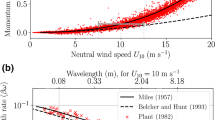Abstract
The problems of wind-induced waves on the sea surface are considered. To this end, the empirical fetch laws that determine variations in the basic periods and heights of waves in relation to their fetch are used. The relation between the fetch and the physical time is found, as are the dependences of the basic characteristics of waves on the time of wind forcing. It is found that about 5% of wind energy dissipated in the near-water air layer contributes to the growth of wave heights, i.e. wave energy, although this quantity depends on the age of waves and the exponent in the fetch laws. With consideration for estimates of the probability distribution functions for the wind over the world ocean [11], it is found that the rate of wind-energy dissipation in the near-water air layer is on the order of 1 W/m2. The calculations of wind waves [19] for the world ocean for 2007 have made it possible to assess the mean characteristics of the cycle of wave development and their seasonal variations. An analysis of these calculations [19] shows that about 20% of wind energy is transferred to the water surface. The remaining amount (80%) of wind energy is spent on the generation of turbulence in the near-water air layer. About 2%, i.e., one tenth of the energy transferred to water, is spent on turbulence generation due to the instability of the vertical velocity profile of the Stokes drift current and on energy dissipation in the surf zones. Of the remaining 18%, 5% is spent directly on wave growth and 13% is spent on the generation of turbulence during wave breaking and on a small-scale spectral region. These annually and globally mean estimates have a seasonal cycle with an amplitude on the order of 20% in absolute values but with a smaller amplitude in relative values. According to [19] and to the results of this study, the annually mean height of waves is estimated as 2.7 m and their age is estimated as 1.17.
Similar content being viewed by others
References
E. N. Lorentz, The Nature and Theory of Atmospheric General Circulation (WMO, Geneva, 1967; Gidrometeoizdat, Leningrad, 1970).
A. H. Oort, “On the Estimates of the Atmospheric Energy Cycle,” Mon. Wea. Rev. 92(4), 483–499 (1964).
P. F. Demchenko, “An Integrated Model of a Planetary Boundary Atmospheric Layer with Nonstationary Equations for the Kinetic Energy of Turbulence and Its Dissipation Rate,” Izv. Akad. Nauk, Fiz. Atm. Okeana 29(3), 315–320 (1993).
M. Bister and K. Emanuel, “Dissipative Heating and Hurricane Intensity,” Meteorol. Atmos. Physics 65(3), 223–240 (1998).
E. B. Kraus and J. A. Businger, Atmosphere-Ocean Interaction. 2nd ed. (Oxford Univ. Press, Oxford, 1994).
S. I. Badulin, A. V. Babanin, V. E. Zakharov, and D. Resio, “Weakly Turbulent Laws of Wind-Wave Growth,” J. Fluid Mech. 591, 339–378 (2007).
Y. Toba, “Wind-Wave Strong Interactions and Quasi-Local Equilibrium between Wind and Sea with the Friction Velocity Proportionality,” Adv. Fluid Mech. 17, 1–59 (1997).
Yu. I. Troitskaya and G. V. Rybushkina, “Quasilinear Model of Interaction of Surface Waves with Strong and Hurricane Winds,” Izv. Akad. Nauk, Fiz. Atmos. Okeana 44(5), 621–646 (2008).
G. S. Golitsyn, Introduction into Dynamics of Planetary Atmospheres (Gidrometeoizdat, Leningrad, 1973) [in Russian].
L. D. Landau and E. M. Lifshits, Mechanics of Continuous Media (GITTL, Moscow, 1953) [in Russian].
A. H. Monahan, “The Probability Distribution of Sea Surface Wind Speeds. Pt I. Theory and Sea Winds Observations,” J. Clim. 19, 497–520 (2006).
A. H. Monahan, “The Probability Distribution of Sea Surface Wind Speeds. Pt II: Dataset Inter Comparison and Seasonal Variability,” J. Clim. 19, 521–534 (2006).
O. M. Phillips, The Dynamics of the Upper Oceans (Cambridge Univ. Press, Cambridge, 1977).
A. N. Babanin and Y. P. Soloviev, “Field Investigation of Transformation of the Wind Wave Frequency Spectrum with Fetch and Stage of Development,” J. Phys. Oceanogr. 28, 563–576 (1998).
S. K. Gulev, et al., “Assesment of the Reliability of Wave Observations from Voluntary Observing Ships,” J. Geophys. Res. 108 (2003).
S. K. Gulev and L. Hasse, “North Atlantic Wind Waves and Wind Stress Fields from Voluntary Observing Data,” J. Phys. Oceanogr. 28, 1107–1130 (1998).
K. Hasselmann, T. P. Barnett, E. Bows, et al., “Measurements of Wind-Wave Growth and Swell Decay during the Joint North Sea Wave Project (JONSWAP),” Deutsch. Hydrograph. Z 12(A8), (1995).
G. S. Golitsyn, “Energetic Geodynamic Cycle,” Izv. Akad. Nauk, Fiz. Zemli, 44(3), 7–12 (2008).
L. Kantha, P. Wittmann, M. Sclavo, and S. Carniel, “A Preliminary Estimate of the Stokes Dissipation of Wave Energy in the Global Ocean,” Geophys. Rev. Lett. 36, L02605, doi: 1029/2008GL036193 (2009).
W. K. Melville, “The Role of Surface-Wave Breaking in Air-Sea Interaction,” Ann. Rev. Fluid Mech. 28, 279–321 (1996).
S. A. Kitaigorodskii, “Determinative Effect of Wind Wave Breaking on Kinetic Energy Dissipation in the Surface Sea Layer and Its Dependence on the Dusturbance Development Stage,” Izv. Akad. Nauk, Fiz. Atmos. Okeana 45(3), 399–407 (2009).
G. J. Komen, L. Cavaleri, M. Donelan, et al., Dynamics and Modelling of Ocean Waves (Cambridge Univ. Press, Cambridge, 1994).
K. Kahma, “On Prediction of the Fetch-Limited Wavespectrum in a Steady Wind,” Finn. Mar. Res. 253, 52–78.
Author information
Authors and Affiliations
Corresponding author
Additional information
Original Russian Text © G.S. Golitsyn, 2010, published in Izvestiya AN. Fizika Atmosfery i Okeana, 2010, Vol. 46, No. 1, pp. 10–18.
Rights and permissions
About this article
Cite this article
Golitsyn, G.S. The energy cycle of wind waves on the sea surface. Izv. Atmos. Ocean. Phys. 46, 6–13 (2010). https://doi.org/10.1134/S0001433810010020
Received:
Accepted:
Published:
Issue Date:
DOI: https://doi.org/10.1134/S0001433810010020



